Full Gardens - How to grow Flowers
Want to learn how to grow beautiful healthy flowers?
 Flowers, often referred to as blooms or blossoms, serve as the reproductive structures in flowering plants, also known as angiosperms (division Magnoliophyta). Their primary role is to facilitate the union of male sperm with female ovum, leading to seed production. This process starts with pollination, followed by fertilization, and culminates in seed formation and dispersal. Seeds represent the next generation of plants and play a crucial role in spreading species across various landscapes. The arrangement of flowers on a plant is known as an inflorescence.
Flowers, often referred to as blooms or blossoms, serve as the reproductive structures in flowering plants, also known as angiosperms (division Magnoliophyta). Their primary role is to facilitate the union of male sperm with female ovum, leading to seed production. This process starts with pollination, followed by fertilization, and culminates in seed formation and dispersal. Seeds represent the next generation of plants and play a crucial role in spreading species across various landscapes. The arrangement of flowers on a plant is known as an inflorescence.
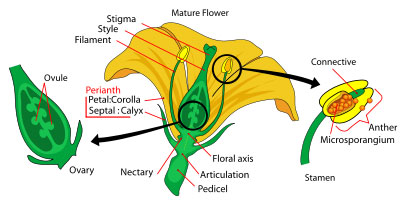
Beyond their reproductive function, flowers have been cherished by humans for centuries for their beauty and as a food source. [top]
Flower Specialization and Pollination
Flowers are uniquely designed to optimize pollen transfer.
Cleistogamous flowers, which are found in some Viola and Salvia species, self-pollinate without opening. This type of pollination ensures seed production even in the absence of pollinators.
Entomophilous flowers attract insects, birds, bats, and other animals to transfer pollen. These flowers often feature nectaries that lure pollinators. They also use visual cues, such as nectar guides, to direct animals to the nectar. Additionally, flowers may emit scents or have vivid colors to attract pollinators. Some species, like certain orchids, mimic the appearance and scent of female bees to lure male bees. The structural arrangement of stamens and pistils in these flowers ensures effective pollen transfer when pollinators visit for nectar, pollen, or mating.
Anemophilous flowers, such as those in grasses, Birch trees, Ragweed, and Maples, rely on wind for pollen transfer. These flowers do not need to attract animals and are typically less visually appealing. They usually separate male and female reproductive organs into different flowers. Male flowers have long filaments with exposed stamens, while female flowers have feathery stigmas. The pollen of wind-pollinated flowers is generally small, light, and not rich in nutrients, in contrast to the larger, stickier, and protein-rich pollen of animal-pollinated flowers. [top]
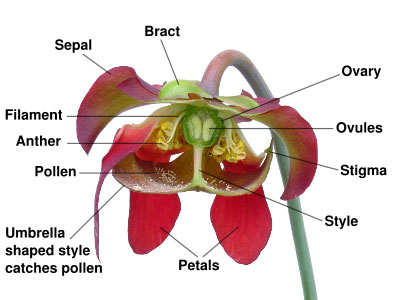
Morphology
Flowering plants, or angiosperms, are known for producing two distinct types of reproductive spores: pollen (male spores) and ovules (female spores). Despite these spores being produced in separate organs, a typical flower contains both, making it a bisporangiate strobilus.
Structurally, a flower is a modified stem with shortened internodes, bearing at its nodes structures that may resemble highly modified leaves. Essentially, a flower forms on a modified shoot or axis with an apical meristem that ceases growth once the flower is formed (a determinate growth pattern). Flowers can attach to the plant in various ways. If a flower lacks a stem and forms in the axil of a leaf, it is termed sessile. When a single flower is produced on a stem, the stem is called a peduncle. If the peduncle ends in a cluster of flowers, each stem holding a flower is known as a pedicel. The flowering stem culminates in a structure called the torus or receptacle, where the parts of a flower are arranged in whorls. These primary whorls, starting from the base of the flower, are:
- Calyx: The outermost whorl of sepals, usually green, though sometimes petal-like in certain species.
- Corolla: The whorl of petals, typically thin, soft, and colored to attract pollinators such as insects.
- Androecium: Comprising one or two whorls of stamens, each stamen includes a filament topped by an anther where pollen is produced. Pollen contains the male gametes.
- Gynoecium: Made up of one or more pistils, the female reproductive organs. Each pistil includes a carpel containing an ovary with ovules (female gametes). The pistil's sticky tip, the stigma, receives pollen, while the style acts as a conduit for pollen tubes to transport sperm to the ovules.
While this description outlines a "typical" floral structure, plant species exhibit a vast range of modifications, which are significant for understanding the evolution of flowering plants. Botanists use these variations to classify and determine relationships among species. For instance, dicotyledons generally have floral organs in multiples of four or five, whereas monocotyledons typically have them in multiples of three.
Most flowers contain both male (stamens) and female (pistils) structures, classifying them as perfect, bisexual, or hermaphroditic. However, some plants produce imperfect or unisexual flowers that only have either stamens or pistils. If a plant species has separate male and female individuals, it is termed dioecious. If male and female flowers are present on the same plant, the species is considered monoecious.
Further discussions on floral modifications are detailed in articles on each flower part. In species with multiple flowers on an axis, known as composite flowers, the collection is termed an inflorescence. This term also refers to specific flower arrangements on a stem. It's important to note that in botanical terms, a single daisy or sunflower is not a single flower but a flower head composed of numerous tiny florets.
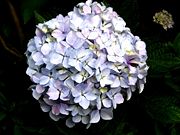
Flowers exhibit various symmetries: if bisected through the central axis, some flowers produce symmetrical halves and are termed regular or actinomorphic, such as roses and trilliums. Others, when bisected in only one way to produce symmetrical halves, are termed irregular or zygomorphic, such as snapdragons and most orchids. [top]
Floral Formula
A floral formula is a shorthand way to describe the structure of a flower using specific letters, numbers, and symbols. These formulas typically represent the flower structure of an entire plant family rather than an individual species. The following notations are commonly used:
- Ca = calyx (sepal whorl; e.g., Ca5 = 5 sepals)
- Co = corolla (petal whorl; e.g., Co3(x) = petals in multiples of three)
- Z = zygomorphic (e.g., CoZ6 = zygomorphic with 6 petals)
- A = androecium (whorl of stamens; e.g., A? = many stamens)
- G = gynoecium (carpel or carpels; e.g., G1 = monocarpous)
- x = variable number
- ? = many
A floral formula might look like this:
Ca5Co5A10-?G1
Additional symbols may also be used to convey more specific information. [top]
Pollination
The primary role of a flower is reproduction. Flowers serve as reproductive organs that facilitate the transfer of sperm contained within pollen to ovules, typically between different plants, though self-pollination is also possible. Fertilized ovules develop into seeds, which represent the next generation of plants. This sexual reproduction process creates genetically unique offspring, enhancing adaptability. Flowers have evolved various structures to promote pollen transfer between plants of the same species. Many plants rely on external factors such as wind and animals, especially insects, to move pollen. Larger animals like birds, bats, and even pygmy possums can also be pollinators. The period during which flowers are fully expanded and functional is known as anthesis.
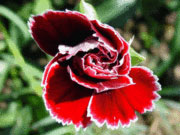
Attraction Methods
Since plants are immobile, many flowers have evolved features to attract animals that can transfer pollen between distant populations. Insect-pollinated flowers, known as entomophilous (Latin for "insect-loving"), are often highly adapted to their pollinators through co-evolution. Flowers may have nectaries on various parts to attract animals seeking nectar. Birds and bees, which have color vision, are drawn to colorful flowers. Some flowers feature patterns called nectar guides, visible under ultraviolet light, which is detectable by bees and other insects. Flowers also use scents to attract pollinators; these scents can be pleasant or unpleasant to humans. Some flowers, like carrion flowers (e.g., Rafflesia, titan arum, and the North American pawpaw), emit odors resembling rotting flesh to attract insects that feed on carrion.
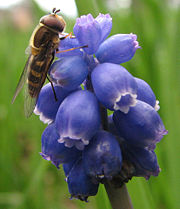
Certain flowers use mimicry to lure pollinators. For example, some orchid species produce flowers that mimic the appearance and scent of female bees, attracting male bees searching for a mate.
Pollination Mechanism
The pollination mechanism employed by a plant is closely tied to its method of pollination. Understanding these mechanisms is essential for appreciating how different plant species achieve reproductive success.
Flowers generally utilize two main pollination methods:
- Entomophilous: These flowers rely on insects, bats, birds, or other animals to transfer pollen. They often have specialized shapes and arrangements of stamens to ensure that pollen grains are transferred to the bodies of pollinators when they land in search of nectar, pollen, or a mate. As pollinators move from flower to flower of the same species, they deposit pollen onto the stigmas with precision. For example, the Sarracenia and lady-slipper orchids have intricate designs to facilitate pollination while preventing self-pollination. Entomophilous flowers usually have large, sticky, and protein-rich pollen grains as an additional reward for pollinators.
- Anemophilous: These flowers use the wind to move pollen from one flower to the next. Examples include grasses, Birch trees, Ragweed, and Maples. Anemophilous flowers do not need to attract pollinators and therefore tend to be less visually appealing. Their pollen is usually small-grained, very light, and of little nutritional value to insects, although bees may gather it in times of scarcity. Unlike entomophilous pollen, anemophilous pollen is not sticky, making it easily carried by the wind.
Some flowers are self-pollinated and never open or are pollinated before they open. These flowers are known as cleistogamous. Many species of Viola and some Salvia exhibit this type of pollination, ensuring seed production even in the absence of pollinators.
Flower-Pollinator Relationships
Many flowers have evolved close relationships with specific pollinators. Some flowers attract only one particular species of insect, relying solely on that insect for successful reproduction. This specialized relationship is a prime example of coevolution, where the flower and pollinator develop traits that complement each other over time.
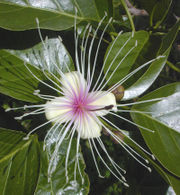
The extinction of either partner in such a relationship can have dire consequences. If a pollinator species declines, the plant species that depends on it may also face extinction. This interdependence highlights the importance of preserving pollinator populations to maintain biodiversity. [top]
Fertilization and Dispersal
Flowers that contain both stamens and a pistil can self-fertilize, which increases the likelihood of seed production but limits genetic diversity. Some flowers, like many dandelions, always self-fertilize. Conversely, many plants have mechanisms to prevent self-fertilization. Unisexual male and female flowers may mature at different times, or pollen from the same plant may be chemically incompatible with its ovules, a condition known as self-incompatibility. [top]
Evolution
Land plants have existed for about 425 million years, initially reproducing through spores, similar to their aquatic ancestors. Early plants like ferns spread genetic clones through water. To adapt to terrestrial environments, plants evolved seeds to protect these genetic copies. Early seed-bearing plants, such as ginkgoes and conifers, appeared before the first flowering plants.
The earliest known flowering plant fossil, Archaefructus liaoningensis, dates back about 125 million years. Despite the lack of continuous fossil evidence, various extinct gymnosperms, especially seed ferns, are considered potential ancestors of flowering plants. The rapid emergence of modern flowers in the fossil record puzzled Charles Darwin, who termed it an "abominable mystery." Recent fossil discoveries and DNA analysis provide insights into how angiosperm characteristics may have evolved step by step.
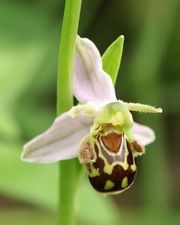
DNA analysis suggests that Amborella trichopoda, found in New Caledonia, is the closest living relative to the earliest flowering plants. This plant's features may resemble those of the first angiosperms.
Flowers likely evolved to involve animals in reproduction, as pollen can disperse without bright colors or elaborate shapes. One theory posits that flowers and their specific pollinators, like wasps, evolved in isolated environments, such as islands, fostering specialized relationships. These symbiotic interactions might have led to the development of highly specialized flowers and pollinators.
Most modern fruits, used in plant reproduction, develop from parts of the flower. These fruits attract animals, which then disperse the seeds.
While flowers have been around for about 130 million years, some evidence suggests they may have existed up to 250 million years ago. The chemical oleanane, used by plants to protect flowers, has been found in ancient fossils, including gigantopterids, which exhibit traits of modern flowering plants.
Early flowers likely had a variable number of parts, arranged in a spiral pattern, and were bisexual. As flowers evolved, they developed more specific numbers and arrangements of parts, often with fused components and distinct sexes. Modern flower evolution continues, with many domesticated flowers heavily influenced by human cultivation and breeding.
Many flowers that were once simple weeds have become popular due to their beauty and adaptation to human cultivation. These flowers have evolved to depend on humans for propagation and survival. [top]
Development
The molecular mechanisms controlling floral organ identity are well understood through the study of gene functions, particularly the ABC model. This model explains how three classes of genes, known as A, B, and C, interact to determine the identity of flower organs in the floral meristem. A-genes are expressed in the first whorl, leading to the formation of sepals. Both A- and B-genes are expressed in the second whorl, forming petals. The third whorl sees the interaction of B- and C-genes to produce stamens, while C-genes alone are responsible for carpel formation in the center of the flower. This model, derived from research on homeotic mutants in plants like Arabidopsis thaliana and Antirrhinum majus (snapdragon), illustrates how alterations in gene functions can change floral organ identities. For instance, a mutation that disrupts B-gene function results in flowers with sepals in place of petals and additional carpels instead of stamens.
Most of the genes central to this model are MADS-box genes, which are transcription factors that regulate the expression of genes specific to each floral organ. These discoveries have significantly advanced our understanding of floral development at the molecular level. [top]
Flowering Transition
The transition to flowering is a critical phase in a plant's life cycle, ensuring reproductive success. This transition is triggered by a combination of internal and external cues, including changes in hormone levels, temperature, and photoperiod. Many perennial and biennial plants require a process called vernalization, exposure to prolonged cold, to initiate flowering. Genes such as CONSTANS and FLC play crucial roles in interpreting these signals, ensuring that flowering occurs at the optimal time for seed development.
Flower formation begins at the tips of stems, involving various physiological and morphological changes. Initially, the vegetative stem primordia transform into floral primordia, marked by biochemical changes that alter the differentiation of leaf, bud, and stem tissues into reproductive organs. The growth of the central stem tip ceases or flattens, while protuberances develop around the stem in a whorled or spiral pattern, eventually forming sepals, petals, stamens, and carpels. Once initiated, this process is irreversible in most plants, continuing even if the environmental cues that triggered it are removed. [top]
Symbolism
Flowers carry deep symbolic meanings in various cultures. For example, lilies often symbolize life or resurrection. The practice of floriography, or assigning meanings to flowers, is well-known in Western culture. Some common examples include:
- Red roses symbolize love, beauty, and passion.
- Poppies represent consolation in times of death and are worn in remembrance of fallen soldiers in the UK, Australia, and Canada.
- Irises and lilies are associated with resurrection and life, often used in burials.
- Daisies symbolize innocence.
Flowers are also prominent in art, often symbolizing femininity and beauty. Artists like Georgia O'Keeffe and Imogen Cunningham have famously depicted flowers as representations of female genitalia. Poets from the Romantic era, such as William Wordsworth and William Blake, drew inspiration from flowers in their works.
Visually, flowers have been a favorite subject for painters like Van Gogh and Monet, whose iconic paintings of sunflowers and water lilies are celebrated worldwide. Flowers are also preserved through drying, freeze-drying, and pressing to create lasting pieces of art.
In mythology, flowers are significant too. Flora is the Roman goddess of flowers and spring, while Chloris holds a similar role in Greek mythology. In Hindu tradition, the lotus is a symbol of purity and divine beauty, often depicted with the god Vishnu. [top]
Usage of Flowers
Flowers play an important role in modern society for their beauty and fragrance. They are used in various events and functions throughout life, including:
- Celebrations of new births or christenings
- As corsages or boutonnieres at social functions and holidays
- Tokens of love and esteem
- Wedding decorations and bridal bouquets
- Home decor for brightening spaces
- Gifts of remembrance for various occasions
- Expressions of sympathy at funerals
People grow flowers in gardens, pick wildflowers, or buy them from florists. The floral industry relies on a vast network of growers and shippers to meet demand.
Flowers, while not as significant a food source as seeds, fruits, roots, stems, and leaves, provide important foods and spices. Edible flowers include broccoli, cauliflower, and artichokes. Saffron, the most expensive spice, is derived from crocus stigmas. Other flower-based spices are cloves and capers, and hops flowers flavor beer. Marigold flowers are used to color egg yolks, and dandelion flowers are made into wine. Honey is another floral product, with variations like orange blossom honey and clover honey.
Many flowers are edible and used to enhance salads with color and flavor. Squash flowers are often fried, and other edible flowers include nasturtium, chrysanthemum, carnation, cattail, honeysuckle, chicory, cornflower, canna, and sunflower. Some, like daisies and roses, are candied.
Flowers are also made into herbal teas. Dried flowers such as chrysanthemum, rose, jasmine, and chamomile are infused for their fragrance and medicinal properties, sometimes mixed with tea leaves for added aroma. [top]
What it all means
Flowers, integral to the reproductive processes of angiosperms, exhibit remarkable diversity and complexity. Understanding their development, pollination mechanisms, and symbolic meanings reveals their crucial roles in both natural ecosystems and human culture. Molecular studies, particularly the ABC model, have elucidated the genetic control of floral organ identity, while the flowering transition highlights the intricate interplay between environmental cues and genetic regulation.
Flowers employ various pollination strategies, including animal-assisted and wind pollination, demonstrating their adaptability and evolutionary ingenuity. Their deep cultural significance spans from ancient mythology to modern celebrations, symbolizing love, beauty, and life transitions. Flowers are not only valued for their aesthetic appeal but also for their practical uses in food and medicine.
In the floral industry, flowers are cultivated and distributed globally, supporting a significant economic sector. Edible flowers and flower-based products, such as spices and herbal teas, showcase the diverse utility of flowers beyond their decorative role.
In conclusion, flowers represent a fascinating intersection of biology, ecology, culture, and commerce. Their study offers insights into plant evolution, genetic regulation, and the intricate relationships between plants and their pollinators. As symbols of beauty and life, flowers continue to inspire and enrich human life in countless ways. [top]

